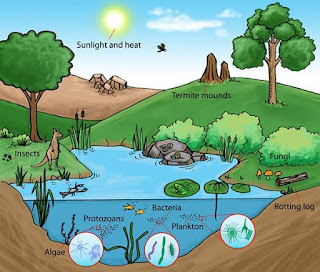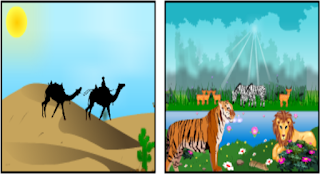Class 8 Science Chapter 18 – Ecosystems Textbook solutions
Important points to remember :
- The world around us is made up of living and non living factors.
- Living are called biotic factors while non living are called abiotic factors.
- The structure which is formed due to these reciprocal relationships is called an ecosystem. Biotic and abiotic factors and their interactions form an ecosystem.
- The organic substances (carbohydrates, proteins and lipids) from dead bodies of plants and animals are converted into inorganic substances (hydrogen, oxygen, calcium, iron, sodium, potassium etc.) by microorganisms. Therefore, microbes are said to be ‘Decomposers’. Variety of ecosystems is found on earth.
- Each place has a different ecosystem. eg. Forest, pond, ocean, river etc. Types of ecosystems are formed according to size, place, climate, types of plants and animals.
- 71 % of the earth surface is covered by water and only 29 % has land on it. Therefore study of aquatic biomes becomes very important.
- According to area, aquatic biomes are widespread. Types of aquatic ecosystems are – Fresh water ecosytem, marine ecosystem, creek ecosystem.
Question 1: Complete the following by using correct option.
a. Air, water, minerals, soil are physical factors of an ecosystem.
( physical, organic, inorganic)
b. River, ponds, ocean are aquatic ecosystem.
(land, aquatic, synthetic)
c. Man is consumer in an ecosystem.
(producer, consumer, decomposer)
Question 2: Match the following
Producers Ecosystem
a. Cactus 1. Forest
b. Aquatic plants 2. Creek
c. Mangroves 3. Aquatic
d. Pine 4. Desert
Answer :
a. Cactus 4. Desert
b. Aquatic plants 3. Aquatic
c. Mangroves 2. Creek
d. Pine 1. Forest
Question 3: Give my information
a. Ecosystem
Answer : The structure which is formed due to these reciprocal relationships is called an ecosystem. Biotic and abiotic factors and their interactions form an ecosystem. Living organisms need different types of abiotic factors and they have different capacities to adapt with those abiotic factors. Some microbes need oxygen, while others don’t. Some plants need more sunlight, while others grow well in shade.
- Each and every abiotic factor (air, water, soil, sunlight, temperature, humidity) affects the biotic factors in the ecosystem.
- The abiotic factors in an ecosystem decide which biotic factors will survive in it and what will be their number.
- The proportion of abiotic factors in an ecosystem is always changing as biotic factors use or excrete abiotic factors.
- Every biotic factor affects abiotic factors as well as other biotic factors around it.
- Every living organism in an ecosystem plays a particular role while living, moving in that ecosystem.
- Variety of ecosystems is found on earth. Each place has a different ecosystem. eg. Forest, pond, ocean, river etc. Types of ecosystems are formed according to size, place, climate, types of plants and animals.
b. Biome
Answer : A biome is a community of plants and animals that have common characteristics for the environment they exist in. They can be found over a range of continents. Biomes are distinct biological communities that have formed in response to a shared physical climate. These biomes differ in their climate, vegetation, and animal life. There are many types of terrestrial biomes but the main biomes include tundra biome, desert biome, forest biome, and grassland biome. The tundra biome is one of extreme weather conditions. Temperatures often remain very cold and harsh.
c. Food web
Answer : A food web is the natural interconnection of food chains and a graphical representation of what-eats-what in an ecological community. Another name for food web is consumer-resource system. Food webs show how plants and animals are connected in many ways. The arrow points from the organism being eaten to the organism that eats it. A food web (or food cycle) is a natural interconnection of food chains.
Question 4: Give scientific reasons
a. Plants in an ecosystem are called consumers.
Answer : Note: Question in part a is wrong as plants are called producers and not consumers.
Plants in an ecosystem are called producers because they produce their own food by the process of photosynthesis. All the other living organisms are dependant on plants for full filling their nutritional requirements and hence are called consumers.
b. Large dams destroy ecosystem.
Answer : Large dams cause environmental damages to rivers, hydrologic basins and surrounding ecosystems, including: the worsening of water quality in rivers; the degradation of aquatic ecosystems and the disappearance of many riparian ecosystems; and serious harms to biopersity, including the extinction of species.
c. Rhinos were restored in Dudhwa forest.
Answer : Rhinos were restored in Dudhwa forest. Dudhwa Forest in Kaziranga National Park. The reason being of the similarities of its habitats to that of the Kaziranga National Park. Moreover, rhinos have been seen in this area till last Century and the adequate protection was available to the rhinos in this area.
Question 5: Answer the following:
a. What are the effects of icreased population on ecosystem?
Answer : More people require more resources, which means that as the population increases, the Earth’s resources deplete more rapidly. The result of this depletion is deforestation and loss of biodiversity as humans strip the Earth of resources to accommodate rising population numbers.
b. How is urbanization responsible for destruction of ecosystem?
Answer : Urbanization causes pollution and the greenhouse effect which in turn affects the growth and development of living things in the ecosystem. Producers have low to no production making survival of living things in other levels of the food chain suffer.
c. What are the reasons for war?
Answer : Eight Main Causes of War :
- Economic Gain.
- Territorial Gain.
- Religion.
- Nationalism.
- Revenge.
- Civil War.
- Revolutionary War.
- Defensive War.
d. Explain the interactions among the factors of an ecosystem.
Answer: Ecosystem include interaction among organisms , and between organisms and their environment . The Brainliest Answer! Ecosystems are made up of living things (biotic factors) and non-living things (abiotic factors) that interactwith each other.
e. Differentiate between evergreen forests and grasslands.
Answer : An evergreen plant is a plant who shed their leaves throughout the year. Hence, they remain green every time. The tropical rain-forest plants are said to be evergreens.
Grasslands are fields where the vegetation is governed by grasses. Grasslands occur usually on all continents except Antarctica. Grassland vegetation can differ in height from quite short, as in chalk grassland, to very tall, as in the example of North American tall grass prairie, South American grasslands, and African savanna.
Question 6: Describe the following pictures.
Answer : Both the images represent three different types of habitats. The first image represents the desert while the second image represents grassland ecosystem and an aquatic ecosystem.
The first image shows a desert and the kind of plants and animals which are found in this type of habitat. There is cactus and camel in this image which are adapted to such harsh environment.
The second image shows a water body which is a type of aquatic ecosystem. It also shows grassland ecosystem which consists of long grasses and variety of plants and animals.
Tags : general science solution for class 8, chapter 11 human body and organ system, class 8 science notes state board, ybstudy class 8 science ncert solutions, std 8 science chapter 15 sound exercise, plants in an ecosystem are called consumers give scientific reasons, standard 8 science, std 8 science chapter 16 reflection of light, ecosystem exercise


